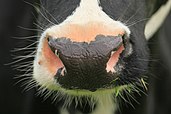This article may have been created or edited in return for undisclosed payments, a violation of Wikipedia's terms of use. It may require cleanup to comply with Wikipedia's content policies, particularly neutral point of view. (July 2022) |
A muzzle print or nose print can be used as a distinguishing pattern for animal identification.[1] The muzzle print is a primary animal biometric characteristic for the recognition of individual cattle. It is a unique animal identifier that is similar to human fingerprints.[2]

Methods
editPaper-based or inked muzzle print collection techniques are available.[3]
Mobile applications can also be used to collect muzzle images of cattle, for image storage as a unique digital identity.[4]
References
edit- ^ "Proceedings of the 2013 Federated Conference on Computer Science and Information Systems". annals-csis.org. Retrieved 2022-07-20.
- ^ Petersen, W. E. (1922-05-01). "The Identification of the Bovine by Means of Nose-Prints". Journal of Dairy Science. 5 (3): 249–258. doi:10.3168/jds.S0022-0302(22)94150-5. ISSN 0022-0302.
- ^ Awad, Ali Ismail; Zawbaa, Hossam M.; Mahmoud, Hamdi A.; Nabi, Eman Hany Hassan Abdel; Fayed, Rabie Hassan; Hassanien, Aboul Ella (September 21, 2013). "A robust cattle identification scheme using muzzle print images". pp. 529–534 – via IEEE Xplore.
- ^ "Cattle identification through facial recognition using muzzle printing -". Dairy news | Dairy news India - dairynews7x7.com. 2021-07-01. Retrieved 2022-07-20.